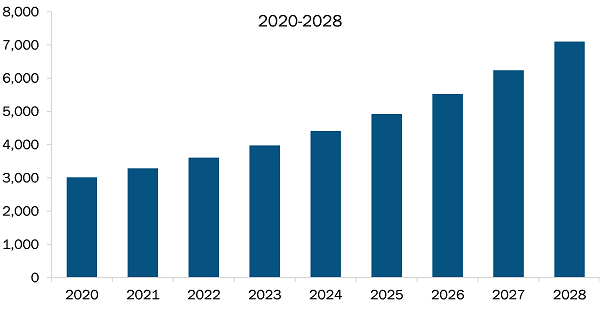Integration of Robotics in Construction Industry will Boost North America and Europe Industrial Automation Market Growth During 2022–2028
According to The Insight Partners market study titled "North America and Europe Industrial Automation Market Forecast to 2028 – COVID-19 Impact and Country Analysis – by Component, System, and End User," the market is expected to grow from US$ 85.05 billion in 2022 to US$ 127.11 billion by 2028; it is estimated to grow at a CAGR of 6.9% from 2022 to 2028. The report provides trends prevailing in the North America and Europe industrial automation market along with drivers and restraints.
The increasing penetration of advanced technology, such as machine learning (ML), the Internet of Things (IoT), and artificial intelligence (AI), has helped accelerate the growth of the industrial automation market. The rising product development and strategic initiatives from key market players for industrial automation applications are adding impetus to the market expansion. For instance, in 2020, Honeywell International Inc. and Tech Mahindra Limited partnered with "Factories of the Future" to accelerate the digital transformation journey by empowering manufacturers. Similarly, Siemens collaborated with SAP SE to offer Industry 4.0-enabled business processes to enterprises. Further, the growing update of the industrial Internet of Things (IIoT) and the upcoming engineering 5G technology are a few factors that are likely to catalyze the North America and Europe industrial automation market growth during the forecast period.
The North America and Europe industrial automation market growth is further accelerated with the growing penetration of connected enterprises, the need for mass manufacturing of products due to increasing demand for real-time data analysis across geographies and the rising uptake of advanced technology across end-use industries to improve performance. In September 2020, the UK government announced plans to invest around US$ 180 million into the second round of its "Manufacturing Made Smarter" scheme to promote interconnectivity and innovation in the country's manufacturing industry.
Key stakeholders in the North America and Europe industrial automation market include component providers, OEMs, system integrators, and end users. In recent years, the demand for industrial automation, especially in the oil & gas industry, has been proliferating due to the heavy implementation of industrial automation solutions across upstream, midstream, and downstream processes in the oil & gas industry. Component providers offer connectivity hardware, sensors, microchip, and various industrial automation OEMs.
Some of the vital industrial automation OEMs are ABB LTD., Omron Corporation, Rockwell Automation, Schneider Electric, and Siemens. Industrial automation OEMs play a crucial role in the ecosystem by developing advanced industrial automation, such as AI and IoT-based industrial automation, and providing them to system integrators, which create a communication link between automated systems that allow plant equipment to communicate more efficiently with operators and other machinery. One of the most common types of system integration is a supervisory control and data acquisition (SCADA), as it combines both software and hardware elements to allow companies to control and monitor their industrial processes on cloud or on-premises.
ABB Ltd.; Schneider Electric SE; Siemens AG; Emerson Electric, Co.; and Rockwell Automation, Inc. are among the key North America and Europe industrial automation market players profiled in the research study. The mentioned North America and Europe industrial automation market players adopt organic growth strategies, such as product launches and expansions, to sustain their position in the North America and Europe industrial automation market.
North America and Europe Industrial Automation Market Revenue and Forecast to 2028 (US$ Million)

North America and Europe Industrial Automation Market 2028
Download Free SampleNorth America and Europe Industrial Automation Market Forecast to 2028 - COVID-19 Impact and Regional Analysis By Component (Hardware and Software), System (Supervisory Control and Data Acquisition, Distributed Control System, Programmable Logic Control, and Others), and End User (Oil & Gas, Automotive, Food & Beverage, Chemical & Materials, Aerospace & Defense, and Others)
The North America and Europe industrial automation market is segmented into component, system, and end user. Based on component, the North America and Europe industrial automation market is categorized into hardware and software. By system, the North America and Europe industrial automation market is segmented into supervisory control and data acquisition, distributed control system, programmable logic control, and others. In terms of end user, the North America and Europe industrial automation market is segmented into oil & gas, automotive, food & beverage, chemical & materials, aerospace & defense, and others.
The rising demand for automation across food & beverage industrial facilities is one of the major factors catalyzing the North American and Europe industrial automation market size. Automation in the food & beverage industry refers to strategic integrations of technologies across various production processes, such as inspection, packaging, and storage. Over the years, food & beverage companies have optimized different production processes through the uptake of automated systems, such as delta robots, automated guided vehicles, and robotic arms, to be in line with various food safety & quality standards laid down by regulatory bodies and reduce overall labor cost across production sites.
Vision-guided robots are experiencing a rise in demand across the sector due to their efficiency in completing repetitive tasks, such as bottle handling, bin picking, and tray loading. Numerous benefits, including enhanced traceability, improved efficiency, and high flexibility, have been driving the need for automation in the food & beverage industry over the years. These factors have encouraged food and beverage producers to invest heavily in automated technology integration across their production facilities. For instance, Utz Brands Inc., an US-based snack brand, announced its plans to integrate automated capabilities across its production plants to reduce its overall operational cost in 2021. Other food & beverage brands rapidly adopting automated technology include Tyson Foods and Cargill, Inc. Thus, the rise in investment in automation across the food & beverage industry is fueling the North America and Europe industrial automation market size.
Contact Us
Phone: +1-646-491-9876
Email Id: sales@theinsightpartners.com